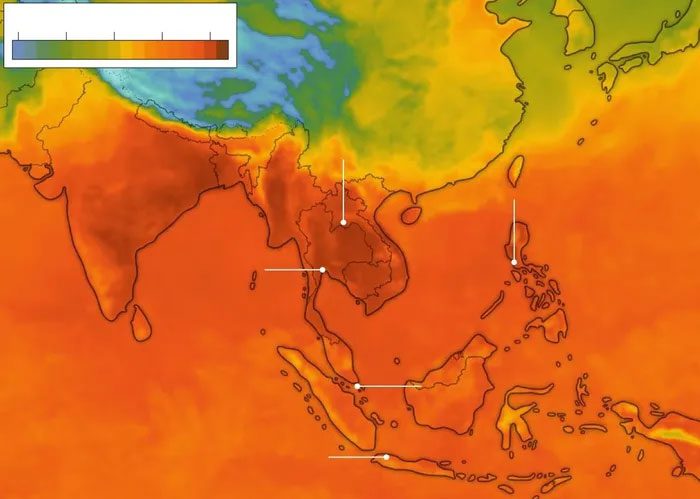At the beginning of 2024, while it is still spring, hundreds of millions of people across South and Southeast Asia are facing scorching hot temperatures. The summer heat has arrived too early, breaking records and even claiming many lives. Moreover, this summer is predicted to be even worse throughout May and June, according to CBS News.
In early May, severe heatwaves caused dozens of deaths across the region. Thousands of schools were forced to close weeks before the summer break.
Scientists are warning about widespread impacts in some of the world’s most populous areas, urging governments to take immediate action to prepare for the effects of climate change and human-induced global warming.

The summer heat has arrived too early, breaking records and even claiming many lives. (Illustrative image).
What is Happening?
Some regions in India recorded maximum temperatures above 43 degrees Celsius last month. On April 21, residents in the eastern city of Bhagdora endured temperatures as high as 46 degrees Celsius.
On April 29, the Indian Meteorological Department (IMD) issued a “red alert” for the eastern and southern states of Andhra Pradesh, Bihar, West Bengal, and Odisha, where temperatures have soared since mid-April. The IMD warned that the heatwave could worsen in the coming days.
At least two people in the southern state of Kerala died, suspected to be from heatstroke over the past weekend. Two other deaths were reported in Odisha due to the heat earlier in April.
The authorities in neighboring Bangladesh were forced to close all schools twice in the last two weeks due to the heat and soaring temperatures nearing 43 degrees Celsius.

Railway workers spraying water on bent tracks due to the heat in Nakhon Si Thammarat province, southern Thailand. (Photo: State Railway of Thailand).
Some areas in Myanmar have recorded record high temperatures exceeding 40 degrees Celsius. The actual temperature feeling—taking into account humidity, wind speed, and other factors—could be even higher.
In the Philippines, thousands of schools closed as vast areas of the country experienced drought and temperatures reached up to 44 degrees Celsius in early April.
In Thailand, the government has urged citizens to stay indoors whenever possible, after 30 deaths were reported as heatstroke this year. In Bangkok, authorities reported that the heat index on May 2 was “extremely dangerous.”
Weather historian Maximiliano Herrera noted in a social media post last week: “Thousands of records are being broken across Asia; this is the most extreme event in global climate history.”
What is the Real Cause?
Scientists have differing opinions on the impact of the ongoing El Niño phenomenon, but many believe that the temporary warming in the central Pacific has altered weather patterns worldwide for years. This has exacerbated conditions this summer in South and Southeast Asia.
Professor Raghu Murtugudde, a climate scientist at the Indian Institute of Technology Mumbai, stated: “I think it is a combination of El Niño, global warming, and seasonality. El Niño is transitioning into La Niña. This is the time when maximum warming occurs in the Indian Ocean.”
Murtugudde noted that the El Niño phenomenon has been forming since March 2023, so the heatwaves last year were also due to the combination of global warming, El Niño, and the annual cycle. However, he mentioned that this year is worse due to the shift towards La Niña.
El Niño refers to the anomalous warming of the sea surface waters in the central and eastern equatorial Pacific. La Niña is the phenomenon where the sea surface waters in the same area cool anomalously.

Heatwaves are attacking Southeast Asian countries. (Photo: Windy, Accuweather).
However, not all climate scientists agree on the impact of El Niño.
Professor Krishna AchutaRao, a scientist at the Center for Atmospheric Sciences at the Indian Institute of Technology, Delhi, stated: “We witnessed heatwaves last year, and the cause was not El Niño.”
Last year, severe heatwaves killed over 100 people in India and Pakistan alone in April and May, once again destroying crops and affecting millions.
“Like this year, last year the heatwave extended from parts of India to Bangladesh and Myanmar, all the way to Thailand. This year it has spread further east to the Philippines. I do not believe El Niño is the cause,” AchutaRao said.
However, most experts agree that climate change is one of the main causes of the devastating heatwaves currently affecting Asia.
AchutaRao, along with other scientists working with World Weather Attribution, has compiled and analyzed data on last year’s heatwaves in the region and dozens of natural disasters that occurred in Laos and Thailand. The research team “concludes that such extreme weather events could not occur without climate change.”
Ko Barrett, Deputy Secretary-General of the World Meteorological Organization, stated last month: “Climate change is exacerbating the frequency and severity of such events, deeply impacting society, the economy, and most importantly, human lives and the environment we live in.”
Who is Suffering the Most?
Murtugudde mentioned that worldwide, countries have attempted to manage the impacts of extreme weather events through early warning and advisory systems, but the poor and densely populated populations in Asia will bear the brunt of the heatwaves.
Heatwaves may continue to cause widespread crop damage, further affecting the livelihoods of farmers who are already facing increasing challenges in recent years.
Many places have restricted outdoor activities to prevent deaths during extreme heatwaves, which have a significant impact on manual laborers in construction—a major part of the rapidly growing economies in Asia.
Scientists and environmental activists globally have been continuously urging countries to reduce greenhouse gas emissions, warning that this is the only way to slow the pace of global warming. Until that happens, experts fear the death toll will continue to rise, and millions will face a dire decision during each heatwave: to work under dangerous conditions or go to bed hungry.


















































